Caballero B. (ed.) Encyclopaedia of Food Science, Food Technology and Nutrition. Ten-Volume Set
Подождите немного. Документ загружается.


quality of the flour used for tandoori roti is similar to
that used for chapati. The flour used for puri, how-
ever, has a lower ash content because 10–15% of
coarse branny materials are removed by sieving;
alternatively, whole-wheat flour can be blended with
20–25% of refined wheat flour.
Wheat Flour
0021 Products such as roomali roti, nan, and South Indian
parotha make use of wheat flour obtained by roller
flour-milling of medium-hard wheat. The flour
should have 9.5–10.5% protein and 0.5–0.7% ash.
Composite Flour
0022 Part of the whole-wheat flour can also be replaced
by other (i.e., non-wheat) cereal flours and flours
obtained from legumes or millets, either to improve
the taste and texture, or to improve the nutritional
quality. Among the legume products used in this way,
the most common is bengal gram flour, which is
normally added at the 20–30% level; the chapati so
made is locally known as a mesi roti. Other flours
that are used, or could be used, in chapati making
at levels ranging from 10 to 20% are defatted soya,
groundnut, or cottonseed flours or refined flours
from barley, bajra, sorghum, maize, cassava, and
sweet potato. Triticale, a man-made cereal, was
found to be unsuitable for chapati-making, but it
can be used after blending with wheat flour in a
ratio of 1:1. Soft wheat, which is also not suitable
for chapati-making, can be improved by blending
with hard wheat, or extra-hard durum wheat. (See
Barley; Cassava: Uses as a Raw Material; Sorghum;
Soy(Soya) Beans: The Crop; Vegetables of Tropical
Climates: Root Crops of Uplands.)
Salt
0023Salt is generally dispersed in water and added to the
dough. Hence, edible common salt of any particle size
can be used.
Oil
0024Refined oil is used during dough preparation and
during rolling and lamination of the dough sheet for
the preparation of parotha and South Indian parotha.
Solid fat (hydrogenated oil) can also be used, after it
has been melted to make it easier to use during lamin-
ation. Solid or plastic fat can also be used in the
preparation of the dough.
Egg
0025Egg is used as an optional ingredient in the prepar-
ation of nan. Fresh egg is normally used in the prep-
aration. It is used to improve the color, texture, and
flavor of nan.
Skimmed Milk Powder (SMP)
0026SMP is an optional ingredient used in the preparation
of nan, while milk or SMP is an essential ingredient in
the preparation of roomali roti. It is added to improve
the texture, flavor, and color.
A C
B
fig0002 Figure 2 Wheat flour-based culinary variations of chapati. (A) South Indian parotha, (B) nan, and (C) roomali roti.
1036 CHAPATIS AND RELATED PRODUCTS

Water
0027 There is no information on the type of water suitable
for chapati-making. Generally, any potable water,
with a medium hardness and a pH value close to
neutrality, is suitable. This is also true for other
variants of chapati.
Influence of Ingredients
Whole-wheat Flour
0028 Since whole-wheat flour is the major ingredient in the
preparation of chapati and other products, its quality
has a considerable influence on the quality of the
end products. Whole-wheat flour obtained from
medium-hard aestivum wheat is preferred, as it yields
a chapati with the desired quality characteristics. The
use of a strong wheat flour, with a protein content of
more than 11.0%, results in a chapati with a tough
and leathery texture, whereas a soft wheat, with less
than 9% protein, yields a chapati with a stiff and
brittle texture. Such chapatis also tend to become
hard and brittle within an hour of storage. A wheat
flour of a similar quality is also well suited for making
tandoori roti, puri, and phulka.
0029The quality of a chapati also depends on the rela-
tive amounts of gliadin, glutenin, and residue protein
present in the flour. A flour with equal amounts of the
above proteins gives fully puffed chapatis with a soft
texture, whereas a flour that has more residue pro-
teins, or gliadin, gives a stiff and leathery chapati. A
flour with a high content of total glutenin has been
found to yield tandoori roti of a highly acceptable
quality. The higher levels of polar lipids in flour result
in chapatis with a soft texture.
0030In addition to the type of wheat, the content of
damaged starch, the diastatic activity, and the sugars
present in the flour affect the quality of a chapati. The
higher the damaged starch content, the higher will be
the water absorption capacity and hence, the softer
the texture of the chapati. A significant direct correl-
ation exists between damaged starch content and
water absorption (r ¼0.89, P < 0.001) and texture of
chapatis (r ¼0.56, P < 0.001). A flour with a high
diastatic activity and sugar content yields a chapati
with a sweetish taste.
0031The characteristics of chapati dough, which are
influenced by the quality of the flour, affect the sens-
ory qualities of the chapati. The sensory texture of a
chapati is related significantly to farinograph consist-
ency (r ¼0.47, P < 0.01), extensograph extensibility
(r ¼0.51, p < 0.01) and resistance to extension
(r ¼0.52, P < 0.01), and textureometer cohesiveness
(r ¼0.57, P < 0.01).
0032Wheat with a low polyphenolase activity is desir-
able to avoid an excessive brownish color in the cha-
pati. These enzymes are found to be low in Indian
wheat varieties, whereas Mexican hybrid wheat var-
ieties, now grown in India, have a high content of this
enzyme. The adverse effect of enzymatic browning is
greater when the chapati dough is rested for a longer
period, or when the baked chapati is stored for a few
hours.
0033Among the different Triticum species, the wheat,
T. aestivum, which yields a nonsticky dough with
good machinability, and a fully puffed chapati with
soft and pliable texture, is most suitable for chapati
preparation. When the species T. durum and T. dicoc-
cum are used for chapati making, dry and hard-
textured products result, which are perceived to be
leathery when chewed. They are also sweeter due
to the higher damaged starch content. In addition to
the type and species of wheat, the severity of grinding
and particle size of the flour play important roles in
influencing the quality of chapatis and other similar
products. Among the different types of mills (plate
mill, hammer mill, pin mill, roller mill, etc.), the flour
obtained from plate mills has been found to be
the best for making chapati, tandoori roti, phulka,
and puri. This is because of the greater severity of
tbl0001 Table 1 Characteristics of resultant atta and whole-wheat flour
Characteristics
a
(%) Resultant atta Whole-wheat flour
Ash 1.31 1.68
Protein 10.80 10.60
Dry gluten 9.90 9.90
Ether extractives 3.20 2.30
Crude fiber 2.09 2.24
Starch 52.20 54.50
Damaged starch 7.00 14.50
Water-absorption capacity
b
62.80 73.50
a
Values are the average of 18 samples and are expressed on a 14%
moisture basis.
b
Required to prepare chapati dough of optimum consistency.
tbl0002 Table 2 Characteristics of whole-wheat (aestivum) flour
suitable for chapati making
Characteristics Level
Ash (%) 1.2–1.5
Protein (%) 9.0–10.5
Sedimentation value (ml) 25–35
Pelshenke value (min) 120–150
Total sugars (%) 2.5–4.0
Diastatic activity (mg/10 g flour) 250–375
Damaged starch (%) 16–18
Water-absorption capacity (%)
a
72–78
a
Required to prepare dough of optimum consistency.
CHAPATIS AND RELATED PRODUCTS 1037

grinding, which results in a flour with a desirable
high damaged starch content, and hence a higher
water absorption, resulting in a soft and pliable
chapati. The soft and pliable characteristics are
retained in products over a long storage period.
The heat developed in such a mill during grinding
tends to yield a chapati with a better flavor. Among
the plate mills, the power- or water-driven mills
are found to be better than hand-driven mills, as
the latter yield flour with a low maltose figure of
1.72–1.99%, and a water-absorption capacity of
just 66–69%, in contrast to the desired higher values
of 2.6–4.65% for maltose content and 72–78% for
water absorption.
0034 A finely ground flour is desirable for chapati and
tandoori roti-making. However, for phulka, the
grinding should be much finer. The coarse flour,
with more than 70–80% overtailing on a 10XX
sieve (130 mm), yields a chapati with a poor appear-
ance and tough texture. The shear force required to
cut such chapatis, which is related to the sensory
texture (r ¼0.67, P < 0.001), is as high as 18–20 kg,
compared with the force of 5–6 kg required for cha-
patis made from normal flour (20–30% overtailing).
The quantity of water required to prepare the chapati
dough of desired consistency is significantly related to
the fraction passing through a 10XX sieve (r ¼0.89,
P < 0.01) and the protein content of the flour
(r ¼0.53, P < 0.05).
0035 The extraction rate of flour has a considerable influ-
ence on the chapati quality. The quality of chapati is
not affected by removing 4–6% of the coarse bran by
sieving (extraction rate 94–96%), as is the practice in
households. However, removing higher amounts of
bran particles by sieving, or using a flour of a lower
extraction rate, makes the chapati tough and leathery.
Hence, to make good chapatis, a considerable amount
of bran needs to be present in flour.
0036 The chapati made from resultant atta is slightly
tough and has a bland flavor; the latter is attributed
to a lower damaged starch content, as well as to the
negligible heat developed during grinding. The tem-
perature reached while grinding in a roller flour mill
can be as low as 30–40
C, as against 90–95
Cina
plate mill. The high temperature reached during the
milling operation seems to favor impartment of a
wheaty aroma in chapatis. This is true for other
products like tandoori roti, parotha, and puri.
0037 If wheat is infected by kernel bunt, at infection
levels above 3%, chapatis will have a dark color and
an undesirable flavor. However, these adverse affects
can be minimized by soaking or washing the infected
grains before grinding. Storing whole-wheat flour for
more than 3 months at a high temperature adversely
affects the quality of chapatis.
Wheat flour
0038Roller-milled flour obtained from medium-hard
wheat is used for the preparation of South Indian
parotha, nan, and roomali roti. The protein content
and the damaged starch in flour are related to
the quality of South Indian parotha. The protein
content of 9.5–10.5% and damaged starch of 10–
12% are desirable (Table 3). The dough used for
roomali roti and South Indian parotha should be
quite extensible, but, at the same time, it should
have sufficient strength. The optimum extensograph
R/E value ranges between 4 and 5 for flours used
in the above products. In nan, the optimum R/E
value is 3–4.
Salt
0039Incorporation of salt in the dough reduces the sticki-
ness and, hence, improves the sheeting characteristics
of chapati dough and other similar products
(doughs). The texture of the products is also
improved considerably.
Oil
0040Incorporation of oil in the chapati dough improves
the texture and pliability. It also keeps the chapati soft
and pliable during storage. Puffing characteristics are
also slightly improved on incorporation of very small
amounts of oil in the dough. Higher levels of fat or
shortening in the dough reduce the puffing quality of
chapatis.
0041Discrete layers in a parotha are due to the applica-
tion of oil during lamination. Oil is also used during
the dough preparation to improve the rolling prop-
erty. Oil is used extensively during stretching and
rolling in the preparation of South Indian parotta,
while it is used in dough as well as stretching in the
preparation of roomali roti. Application of oil during
lamination helps to produce discrete laminations in
South Indian parotha. However, in the case of room-
ali roti, the oil helps to produce a very thin sheet of
dough.
Water
0042The amount of water required to prepare a dough of
optimum consistency for chapati preparation ranges
from 70 to 80%. The amount depends on several
factors, such as the type of wheat, grinding method,
extraction rate, particle size distribution, severity of
grinding, etc. The higher the water requirement, the
softer will be the texture of the chapati and the
sweeter the taste. Such chapatis keep well on storage.
The amount of water required for phulka is higher
and ranges from 75 to 80%. The dough for the prep-
1038 CHAPATIS AND RELATED PRODUCTS

aration of tandoori roti requires slightly higher levels
of water as the dough is made slightly loose to enable
sheeting between two palms. The South Indian par-
otha and roomali roti require less water since they are
made from wheat flour milled in a roller flour mill
with a low damaged starch content; moreover, oil in
dough reduces the water absorption capacity.
Additives
0043 The incorporation of yeast (0.5%) or yogurt (10%)
softens the texture, which is also retained during
storage. Emulsifiers or surfactants, such as glycerol
monostearate, sucrose esters, and sodium stearoyl
lactylate (SSL), and the enzyme, amylase, also im-
prove the texture of a chapati as well as its keeping
quality. The use of glycerol monostearate (GMS) in
nan improves its texture. Incorporation of SSL and
DATEM (diacetyl tartaric acid esters of monoglycer-
ides) improves the softness of South Indian parotha.
Cysteine, HCl at a level of 50 ppm further improves
the machinability of the dough and texture of South
Indian parotha. (See Emulsifiers: Organic Emulsi-
fiers; Enzymes: Uses in Food Processing.)
Methods of Production
0044 Chapatis and their culinary variations are generally
freshly made and served, while still hot, in house-
holds, restaurants, and industrial canteens. Fresh,
hot chapatis are preferred, as they have a better flavor
and soft texture. Consequently, chapatis produced on
a large scale and marketed in unit packs have not
become popular among consumers.
Chapati
0045 The method of preparation of chapatis involves three
important steps, viz. preparation of the dough,
sheeting, and baking-cum-puffing (Figure 3).
0046The main ingredients used in chapatis are whole-
wheat flour, or resultant atta, and water. The water
level varies from 65 to 75%, depending on the type of
wheat and the milling method. In households, and
even in restaurants, the dough is kneaded by hand to
a consistency that is stiffer than bread dough, but
enables easy sheeting without sticking to the base of
the rolling pin. In large industrial canteens, however,
either a planetary vertical mixer with a U-shaped
blade, or a horizontal mixer similar to that used for
bread dough, is used. The dough is mixed for 10–
15 min, for complete development of the gluten,
rested for a period ranging from 30 to 120 min
depending on the convenience. Normally, dough is
rested for proper hydration and for stress relaxation,
which enables easy sheeting with minimal stickiness.
The optimum resting time required is shorter
(15–20 min) for a dough mixed in a mixer but longer
for hand-mixed dough (30–120 min).
0047The dough is divided into 35–40 g pieces and then
rounded between the palms. The rounded dough is
sheeted (using a rolling pin) to a circular shape of
about 15 cm in diameter and 1.5–2.0 mm in thickness.
Dusting with flour is normally done to reduce the
stickiness. The rolled circular dough sheet is then
baked on each side on a heated shallow iron plate
(200–220
C), for a total time of 1–2 min. At the
final stages of baking on the second side, the sur-
face of the chapati is gently pressed with a clean
dry cloth for puffing. Alternatively, puffing can also
be done by placing the chapati immediately after
baking on a gas flame or live, glowing coals for a
few seconds. The hot chapati is served either as such,
or after smearing the surface with fat, preferably ghee
or butter.
0048As yet, little work has been carried out on the
mechanization of chapati production, particularly
with respect to sheeting or baking. However, in some
countries, the equipment generally used for the manu-
facture of tortillas is also used for chapati sheeting
tbl0003 Table 3 Quality characteristics of flour suitable for chapati and its variants
Characteristics Whole-wheat flour Wheat flour
Chapati Phulka Tandooriroti Puri South Indianparotha Nan
Ash (%) 1.2–1.5 1.2–1.5 1.2–1.5 1.0–1.2 0.5–1.0 0.5–1.0
Protein (%) 9.0–10.5 9.0–10.5 9.0–10.5 9.0–10.0 10.0–11.0 8.5–9.5
SV (ml) 25.0–35.0 25.0–35.0 25.0–30.0 20.0–30.0 25.0–35.0 25.0–35.0
PV (min) 120–150 120–150 110– 140 100–120 130–160 125–150
DA (mg/10 g flour) 250–375 375–400 225– 350 200–300 175–250 150–205
Damaged starch (%) 16–18.0 18–20 13–15 12–14 8–10 7–9
Water absorption (%)
a
72–78 75–80 70–75 65–70 62–65 52–60
Particle size (throughs of 130 mm) 80–90 85–95 75–85 70–80 100 100
a
Required to prepare dough of optimum consistency.
SV, sedimentation value; PV, Pelshenke value; DA, diastatic activity.
CHAPATIS AND RELATED PRODUCTS 1039
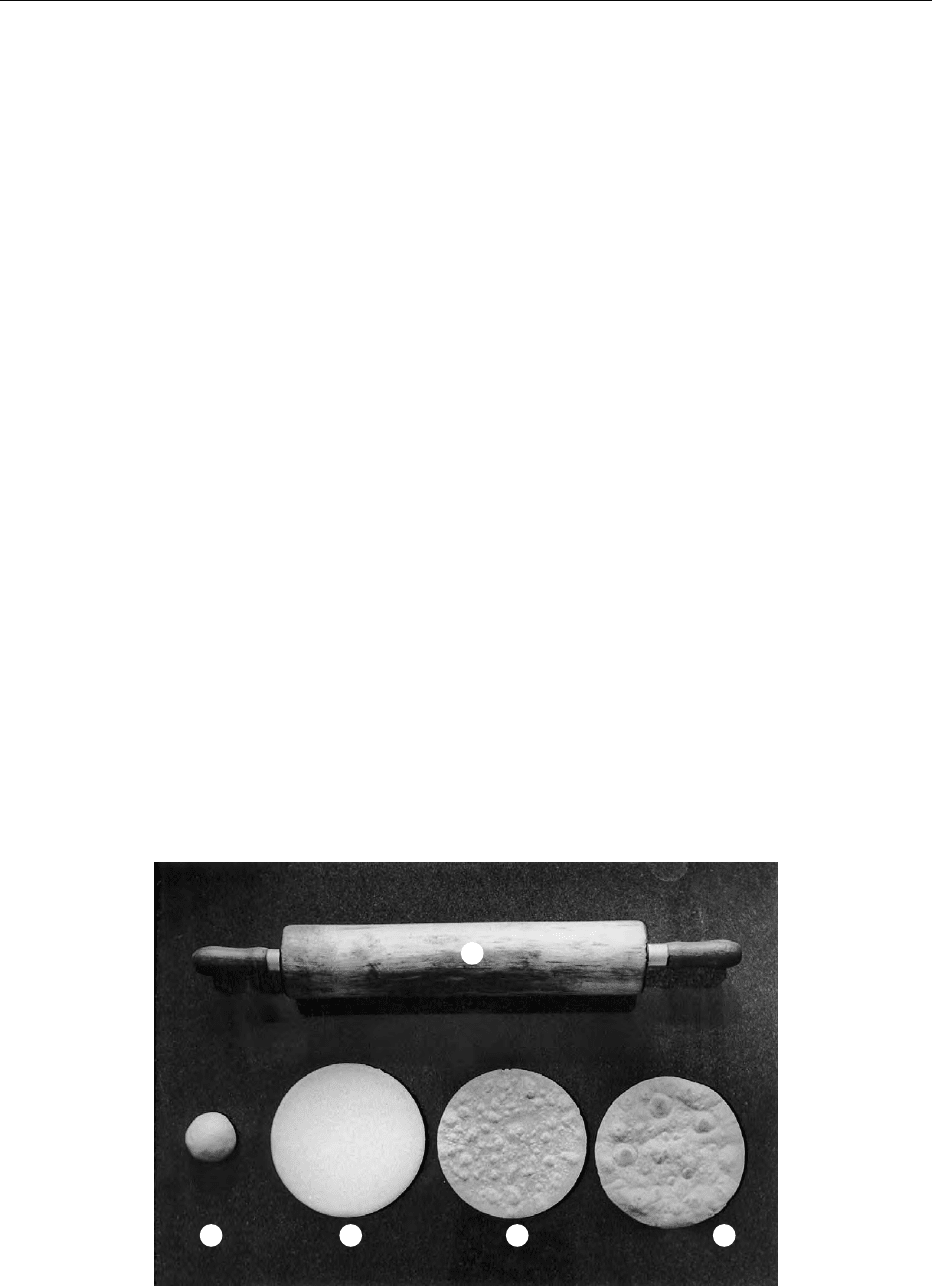
and baking. A few mechanized chapati-sheeting units
have been developed, and are being used in restaur-
ants and industrial canteens. (See Tortillas.)
0049 Sheeting of dough using a rolling pin is time-
consuming and requires experienced persons to
produce chapatis with a circular shape as well as
uniform size and thickness.
Shaping by Pressing
0050 Simple machines are now available to shape chapati
dough. A ‘Hillif’ chapati press with a capacity to
produce 100–200 chapatis per hour is used in some
households and restaurants for sheeting. It consists of
two circular cast iron disks connected by a hinge. The
contacting surfaces are covered with Teflon sheets. A
lever-type handle is attached to the bottom disk.
About 30–40 g of dough are placed at the center of
the bottom disk and covered by the top disk, and
pressure is applied to the top disk for a few seconds
with the help of the lever.
0051 The pressed chapati is removed carefully and
baked. Oil is applied to the surface of the disk to
avoid sticking.
0052 Another mechanical device available for flattening
chapati dough is based on the principle of the can
flanker, and consists of two disks, one fixed, the other
movable. A toggle mechanism is used to press the
dough, which is placed in between the disks, as it
develops a high pressure with little effort. The thick-
ness of the chapati can be varied by adjusting the
clearance between the disks. The bottom plate, on
which 40–50 g of dough have been placed, is made
to press onto the top disk, with the help of a pedal
connected to the toggle. This machine has the cap-
acity to produce 200–300 chapatis per hour. This
device is either hand- or foot-operated.
Shaping by Sheeting
0053All the equipment described above is of the batch
type. Hence, little effort has been made to develop
continuous shaping machines for shaping by sheeting,
which is accomplished by feeding the dough through
a hopper and passing it through four sets of roller to
attain the desired thickness. The sheet then passes
under a rubber-lined drum, and is cut (or stumped)
with a Teflon-coated cutter of 18 cm diameter. The
scrap dough is fed back to the hopper. The machine
has the capacity to produce 1200–1800 chapatis per
hour. Some machines, based on continuous sheeting
and rotary cutting, are now available for the shaping
of chapati dough.
Shaping and Baking
0054A new device, known as a ‘roti maker’, is now on the
market. It can be used for shaping, baking, and
puffing. The device is similar to the ‘Hillif’ chapati
press, but the two disks are heated through the elec-
tric coil attached to the disk. About 30–40 g of dough
are placed at the center of the bottom disk. The
pressure is applied at the top disk for a few seconds
A B C D
E
fig0003 Figure 3 Method of preparation of chapati. (A) Dough ball, (B) sheeted dough, (C) partially baked chapati, (D) puffed chapati, and
(E) rolling pin.
1040 CHAPATIS AND RELATED PRODUCTS
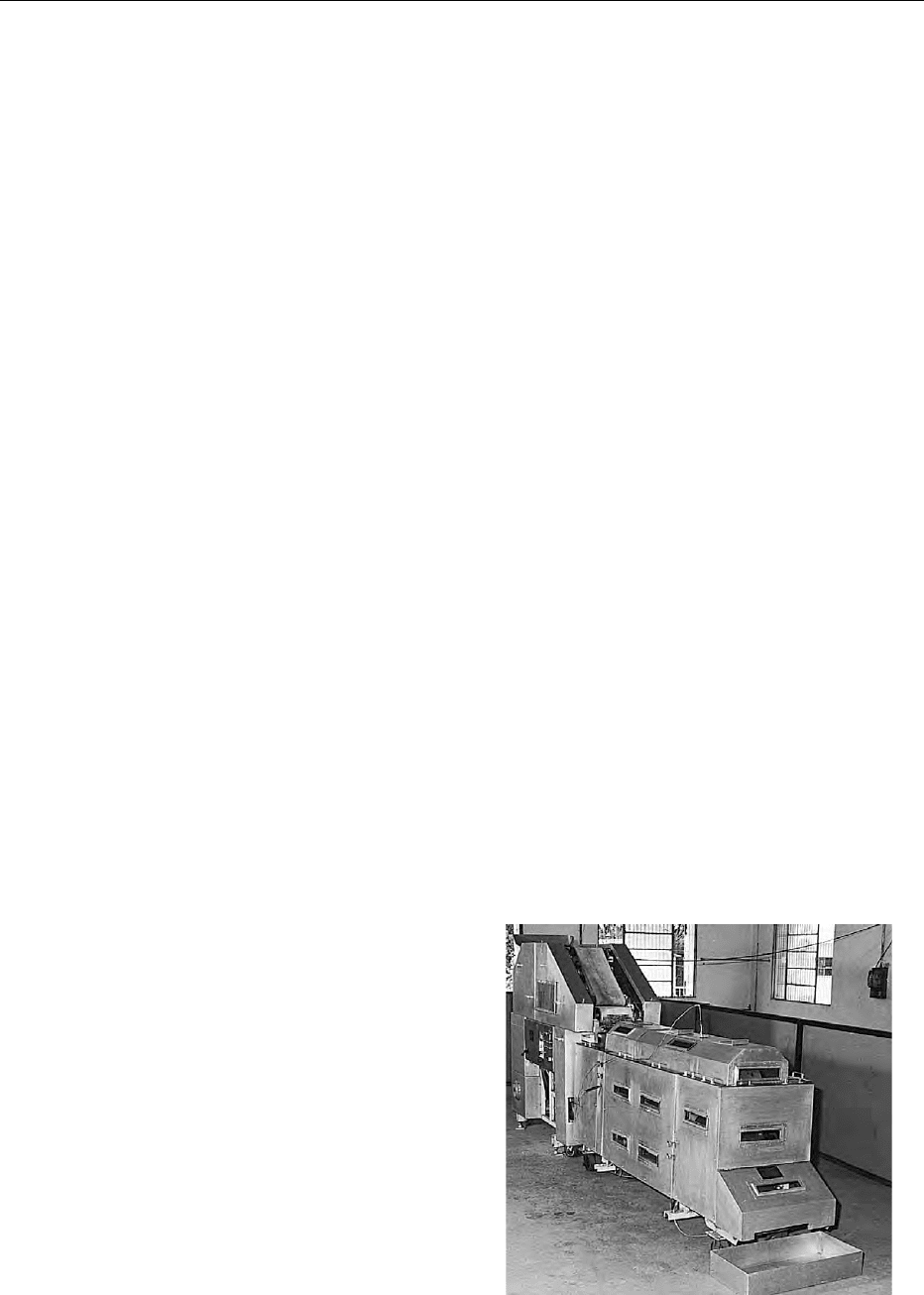
and allowed to bake. The chapati gets baked and lifts
the top disk while puffing, and the puffed chapati is
removed and served.
Continuous Shaping, Baking, and Puffing Units
0055 A continuous chapati-making machine, designed and
developed by Central Food Technological Research
Institute, Mysore, India, is being fabricated by differ-
ent machine manufacturers, and is now on the market
(Figure 4). The machine has the capacity to produce
600–800 chapatis per hour. The process involves
preparation of the dough in a planetary mixer. The
dough is continuously conveyed to the extruder. A
fish tile die moves the dough sheet to the endless
belt conveyor. The sheet travels on the conveyor and
passes through a rotary cutter and gets uniformly cut
into a circular shape. These chapati sheets enter the
baking chamber, while the remaining/cut portions of
the sheet are trapped and returned to the extruder.
The fuel used for baking is liquid propane gas. The
baking chamber consists of a three-tier endless con-
veyor system. The conveyors are heated by ribbon
burners at the bottom. At the third stage, the chapatis
are exposed to a direct flame to yield a puffed
product, which is collected in a tray.
Phulka
0056 The preparation method, ingredients, and consist-
ency of the dough are similar to those of chapatis.
However, the flour requires higher amounts of water
(75–80%) to form the dough. About 20–25 g dough
are sheeted using a rolling pin to a very thin circular
sheet (0.8–1.0 mm) of about 8–12 cm in diameter.
The dough sheet is baked on each side on a shallow
heated iron plate or hot plate maintained at 200–
220
C for 1–1.5 min and puffed on glowing coal or
a live fire. In view of the lighter weight, puffing of
phulka is complete. Hot phulka is consumed after
smearing with oil, ghee, or butter before serving.
0057 Phulka is also prepared using salt (0.5%) and oil
(4–6%) in the dough. This helps in sheeting the dough
very thinly, and the resulting phulka will have a softer
texture. Phulka, particularly that made with salt and
oil, can remain mold-free for about 5–6 days.
Puri
0058 Puri is a deep-fat-fried product made from a whole-
wheat flour of low extraction rate 85–90%. The
dough made by kneading flour and water is sheeted
to a thickness of 1.5–2 mm and a diameter of
10–12 cm using a rolling pin. The sheeted dough is
deep-fat-fried in oil maintained at 180–200
C for
about 1 min with intermittent turning. The frying is
continued till the puri puffs fully and results in a light
golden brown color. Intermittent pressing of puri
while frying with perforated ladle helps in puffing.
Puri is then removed from the oil bath with a perfor-
ated ladle. It is normally consumed hot, along with
boiled and spiced vegetables.
Parotha
0059The dough made by kneading whole-wheat flour, salt
(1.0–2%), fat (2–5%) and water (65–70%) is divided
into pieces of 35–45 g and sheeted, using a rolling pin,
to a circular shape of 10 cm diameter. Then, oil is
applied to the top surface (1–2 g) and spread uni-
formly. The sheet is folded into a semicircle, and oil
is again uniformly applied over the surface (0.5–
1.0 g); the semicircle is then folded into a quarter
circle. This laminated piece of dough is then sheeted
(by rolling) into the shape of a triangle with a thick-
ness of 2–3 mm, and sides of 15–18 cm in length. The
sheeted dough is baked on an electric hotplate or
heated shallow iron plate, for about 1–2 min until
the color becomes light brown. Oil is applied to
both sides (1–2 g) while baking (Figure 5).
0060No attempt has been made so far to mechanize the
sheeting and lamination processes in parotha-making.
Stuffed Parotha
0061A parotha stuffed with vegetables and spices, so that
it may be eaten as such, without any side dishes, is
known as ‘stuffed parotha’. The dough for stuffed
parothas is made in the same manner as that for
parothas. A filling is prepared by adding chopped
onion (25 g), salt (1 g) and chilli powder (0.5 g) to
fig0004Figure 4 Chapati-making machine.
CHAPATIS AND RELATED PRODUCTS 1041
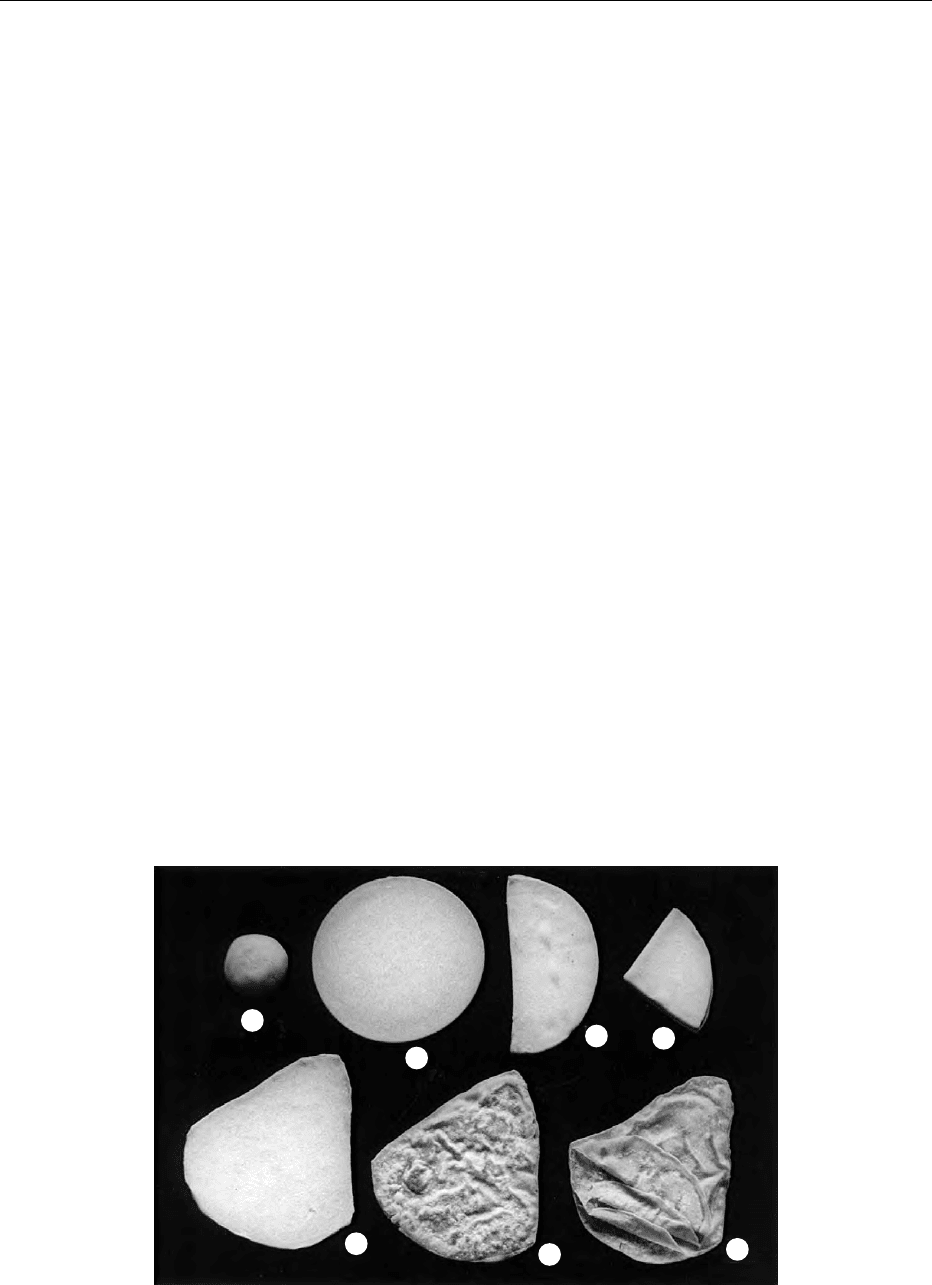
boiled, peeled, and mashed potato (100 g), and
mixing the ingredients well. A small portion of filling
(about 20 g) is placed on the center of the sheeted
dough (5 cm diameter). The dough is folded over the
filling to make a ball again. The dough is then rolled
into a circular shape (12–15 cm) and baked on a
hotplate by applying oil or butter to both sides.
0062 The ingredients of the filling may be changed,
depending on the availability of vegetables and prefer-
ences of consumers. Stuffed parothas can be prepared
using radish, cauliflower, fenugreek leaves, etc. Some-
times, vegetables are mashed and mixed along with
dough and parothas prepared in the normal manner.
Tandoori Roti
0063 The ingredients used are the same as those used for a
chapati, except that salt (1.25–1.5%) is sometimes
added. The quantity of dough used for a tandoori
roti is higher (40–60 g) than for a chapati (35–40 g).
The dough is flattened by beating and pressing
between the hands to a thickness of 4–6 mm and a
diameter of 15–18 cm. The sheeted dough is baked in
an oval-shaped oven, the walls of which are plastered
with clay (a tandoor, Figure 6). The oven is heated by
burning wood or coal in the bottom. The sheeted
dough is placed on a cloth pad, and pasted to the
heated walls of the tandoor. Depending on the tem-
perature of the tandoor, the roti is baked in 60–90 s.
When the roti has been baked properly, it falls from
the side of the wall to the bottom surface. The baked
roti is then taken out, using a long L-shaped iron rod.
The major heat transfer in a tandoor oven is mainly
by radiation, though some heating also occurs
through conduction and convection.
South Indian Parotha
0064The dough is prepared by mixing wheat flour
(100%), salt (1.0%), sugar (0.5%), egg (0.1%) and
water (55–58%). It is then rested for 30 min, divided
into 75 g portions, rounded and again rested for
10 min. Next, the dough is sheeted with a rolling
pin, and oil is applied while sheeting. The thin
dough sheet thus obtained is folded to form multiple
layers and then coiled (Figure 7). The coiled dough is
rested for 10 min, then sheeted again to a final thick-
ness of 5 mm using a rolling pin. The dough sheet is
then baked at 230–240
C for 2 min on a hotplate, or
on a shallow iron plate heated by gas or coal, and
turned every 15 s. Oil is applied during baking, and
the parotha is served hot and consumed along with
spiced boiled vegetables.
Nan
0065Nan is prepared from refined wheat flour. The
dough is made from wheat flour (100%), milk
(6%), curd (12%), salt (1%), baking soda (0.5%),
fat (4%), and egg (3%). The dough is fermented for
4 h; thereafter, 80 g of dough are sheeted to a thick-
ness of 2.5 mm, using a rolling pin, and baked in a
tandoor oven maintained at 350–365
C for 60 s. Nan
is served hot, and it is normally made in restaurants or
A
B
C
D
E
F
G
fig0005 Figure 5 Method of preparation of parotha. (A) Dough ball, (B) circular dough sheet, (C) first fold, (D) second fold, (E) sheeted
parotha, (F) baked parotha, and (G) different layers of parotha.
1042 CHAPATIS AND RELATED PRODUCTS
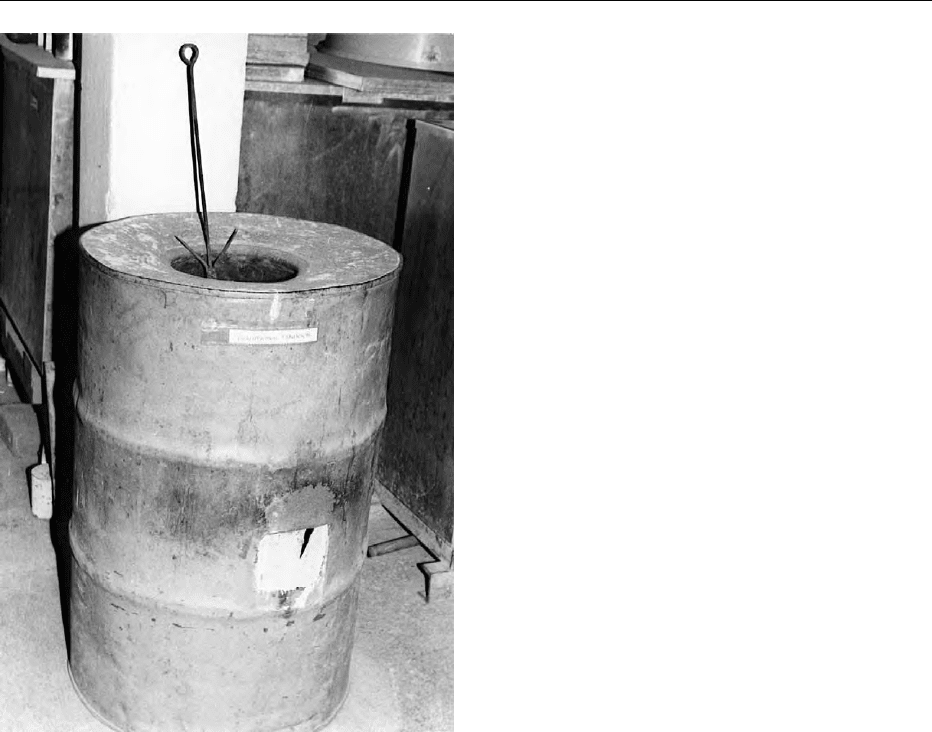
small shops known as ‘Dhabas’, using a tandoor oven
similar to that used for the preparation of tandoor
roti.
Roomali Roti
0066 Roomali roti is prepared using refined wheat flour,
milk powder, fat, salt, and water. The dough made by
mixing these ingredients is rested for about 30 min.
About 100–200 g of the dough are stretched through
fingers to a very thin transparent sheet, to a thickness
of 0.5–0.8 mm and a diameter of 60–90 cm. The
dough sheet is then placed on a heated (350–
360
C), inverted shallow iron plate and baked for
60–90 s. The baked roomali roti is semi-folded, quar-
ter-folded, and served hot.
Handling, Storage, and Distribution
0067 As already mentioned, chapatis and other similar
products are normally consumed fresh and hot. On
storage, they stale, becoming brittle, and hard, and
lose their typical flavor; hence, they are not liked
by consumers. The very short keeping quality of cha-
patis poses serious problems when they have to be
served to a large number of consumers at one time,
as in industrial canteens or in restaurants. A good
chapati would be expected to retain its soft, pliable
texture for at least 2–3 h. No serious mechanization
attempts have been made to enable large-scale prep-
aration and distribution of such products. Persistent
research and development efforts are also being
made in different parts of the world to improve
upon the storage and distribution of chapatis. How-
ever, in some parts of the world, the baked chapati is
now being marketed in unit packs. These chapatis
need to be stored in a refrigerated condition. They
are heated or warmed in a microwave oven before
consumption.
0068The chapati, being a high-moisture product, con-
taining 28–30% moisture, stales like bread or cake,
becoming less acceptable on storage. Compared with
other bakery products, a perceptible staling is ob-
served on cooling. Further storage tends to make
chapatis hard and brittle. In addition to these
changes, mold growth also occurs after 3–4 days of
storage.
0069Sorbic acid is normally used as an antifungal agent
for preserving chapatis/parothas. The maximum level
that could be incorporated without affecting the taste
is 0.1%. The mold growth is delayed by 2–3 days at
this level. However, the use of a higher level of sorbic
acid (0.3%) along with 1.5% salt, and packing in
polythene (200 gauge), or in an aluminum foil/poly-
thene laminate, can delay mold growth for as long as
180 days. Sorbic acid is found to be a better preserva-
tive than its potassium salt. The level of sorbic acid
could be reduced further either by including 0.4%
citric acid, 3% sugar, and 2.5% salt in the recipe, or
by heating the packed chapatis for 2 h at 90
C. The
chapatis made for defense personnel are preserved by
in-pack heat sterilization after being packed in paper/
foil/polylaminate. Such chapatis can be preserved for
180 days. Subjecting packed chapatis/parothas to g
radiation of 1 Mrad also delays the mold growth for
180 days. Parothas can be preserved well for 10
months by using 0.19% sorbic acid and 1.6% salt;
the inner pack, made of MST (moisture-proof seal-
able and transparent) cellophane, is repacked in
paper/foil/polythene pouches. (See Spoilage: Molds
in Spoilage.)
0070A shelf-life of one year can be obtained for prod-
ucts such as chapatis/parothas/stuffed parothas
by packing under a moderate vacuum of about
560 mmHg in sanitary cans, and heating in an oven
at 115–120
C for 1 h.
0071For civilian consumption, polypropylene or poly-
thene metallized polyester laminate pouches are
fig0006 Figure 6 Tandoor oven.
CHAPATIS AND RELATED PRODUCTS 1043
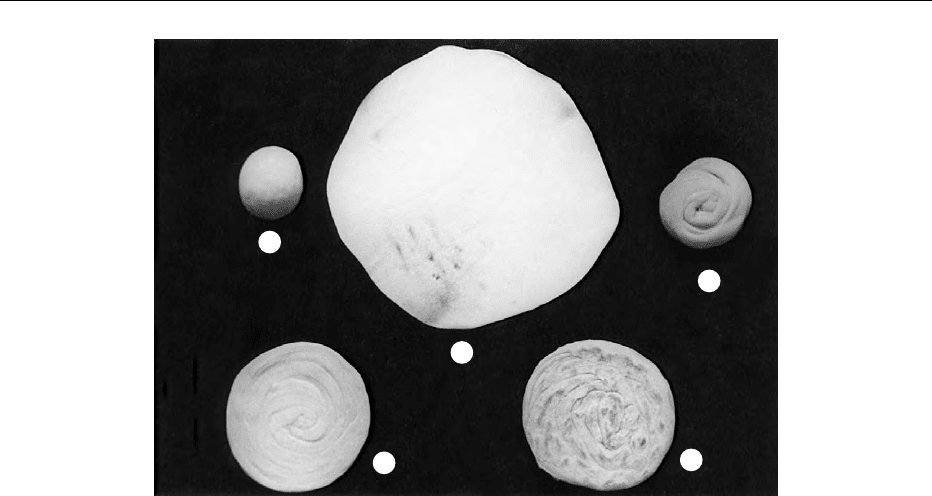
found to be quite adequate. Four chapatis are
packed and sealed in each pouch. The individual
packets are then packed in fiberboard boxes for trans-
portation.
0072 The puri can be stored for a slightly longer period
of 4–5 days, but it becomes hard and brittle within
2–3 days. South Indian parotha remains mold-free
only for 3–4 days. Its life could be extended using
sorbic acid at 0.15% level, but the parotha can
become hard and brittle. The tandoor roti and nan
also can be stored for the same period as a chapati.
No serious efforts have been made to market these
products in unit packs.
See also: Barley; Emulsifiers: Organic Emulsifiers;
Enzymes: Uses in Food Processing; Flour: Roller Milling
Operations; Niacin: Properties and Determination;
Riboflavin: Properties and Determination; Sorghum;
Soy (Soya) Beans: The Crop; Spoilage: Molds in
Spoilage; Starch: Structure, Properties, and
Determination; Thiamin: Properties and Determination;
Tortillas; Vegetables of Tropical Climates: Root Crops
of Uplands; Wheat: The Crop; Cassava: Uses as a Raw
Material
Further Reading
Arya SS, Vidhyasagar K and Parihar DB (1977) Preserva-
tion of chapati. Lebensmittel-Wissenschaft und Techno-
logie 10: 208–210.
Austin A and Ram A (1971) Studies on Chapati Making
Quality of Wheat. Technical Bulletin, No. 31, New
Delhi: Indian Council of Agricultural Research.
Faridi H (1988) Flat breads. In: Pomeranz Y (ed.) Wheat:
Chemistry Technology, vol. II, pp. 457–506. St. Paul,
MN: American Association of Cereal Chemists.
Haridas Rao P (1982) Studies on Chapati and Similar
Traditional Foods. PhD thesis, University of Mysore.
Indrani D (1998) Rheological Characteristics of Wheat
Flour Dough in Relation to Quality of Parotha – an
Indian Traditional Food. PhD thesis, University of
Mysore, Mysore, India.
Qarooni J (1996) Flat breads. In: Qarooni J (ed.) Flat Bread
Technology. New York: Chapman & Hall, International
Thomson Publishing.
Saxena DC (1996) Studies on Tandoori Roti – An Indian
Traditional Food. PhD thesis, University of Mysore,
Mysore, India.
Sidhu JS and Seibel W (1988) Effect of flour milling condi-
tions on the quality of Indian unleavened flat bread
(chapati). Journal of Food Science 53: 1563–1565.
A
B
C
D
E
fig0007 Figure 7 Method of preparation of South Indian parotha. (A) Dough ball, (B) circular dough sheet, (C) coiled dough sheet, (D) sheeted
South Indian parotha, and (F) baked South Indian parotha.
1044 CHAPATIS AND RELATED PRODUCTS

CHEESES
Contents
Types of Cheese
Starter Cultures Employed in Cheese-making
Chemistry of Gel Formation
Chemistry and Microbiology of Maturation
Manufacture of Extra-hard Cheeses
Manufacture of Hard and Semi-hard Varieties of Cheese
Cheeses with ‘Eyes’
Soft and Special Varieties
White Brined Varieties
Quarg and Fromage Frais
Processed Cheese
Dietary Importance
Mold-ripened Cheeses: Stilton and Related Varieties
Surface Mold-ripened Cheese Varieties
Dutch-type Cheeses
Types of Cheese
N F Olson, University of Wisconsin, Madison, WI, USA
Copyright 2003, Elsevier Science Ltd. All Rights Reserved.
Definition of Cheese
0001 Like many fermentation-derived food products,
cheese cannot be easily and succinctly defined. Early
versions of cheese were likely a soft gel/curd formed
through acidification of milk from a mammal by
contaminating lactic acid bacteria. A general defin-
ition of cheese has recently been accepted by inter-
national food regulatory bodies, which illustrates
the complexity of defining this complex food. It
is defined as the ripened or unripened soft or semi-
hard, hard or extra-hard product, which may be
coated, and in which the whey protein:casein ratio
does not exceed that of milk, obtained by: (1) co-
agulating wholly or partly the protein of milk,
skimmed milk, partly skimmed milk, cream, whey
cream or buttermilk, or any combination of these
materials, through the action of rennet or other suit-
able coagulating agents, and by partially draining the
whey resulting from such coagulation; and/or (2)
processing techniques involving coagulation of the
protein of milk and/or products obtained from milk
which give an end product with similar physical,
chemical and organoleptic characteristics defined
under the Codex Committee entry in the Further
Reading section.
History of Cheese
0002The large number of different names (varieties) of
cheeses resulted from the long history of cheese
manufacturing, the use of milk from various animals,
and development of unique technologies usually by
accident but also dictated by environmental condi-
tions. These differences were further compounded
by the isolation of cheese manufacturing regions and
differences in languages that resulted in cheeses that
were similar but were given different names. Regional
and nationalistic pride institutionalized the plethora
of names of cheeses, which is estimated to exceed
1000. Subsequent trade between regions spread the
notoriety and consumption of certain cheese varieties,
presumably based upon their acceptable characteris-
tics but also their ability to retain desirability during
transport.
0003It is generally accepted that cheese as a distinct
product evolved in the Middle East, specifically in
the Fertile Crescent between the Tigris and Euphrates
rivers. Domestication of animals such as goats and
sheep led to their use as sources of meat, milk, and
hides. These early herdsmen must have deduced that
suckling animals derived satisfaction and growth
promoting factors from the mothers’ milk. Gaining
sustenance from a product without sacrificing the
animal for meat would likely have led to taking a
portion of the mothers’ milk for human consumption.
The highly nutritious blend of components in milk
promoted the growth of various microorganisms,
including lactic acid-producing bacteria that
CHEESES/Types of Cheese 1045
